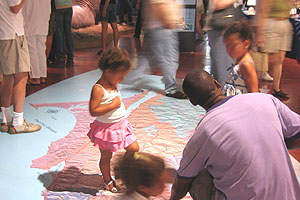
I spent the 4th of July at the Marin County Fair, befriending llamas, riding the Ferris wheel, eating ice cream, and exploring an oversized floor map of Marin watersheds--part of an "Aquatic Adventures" exhibit that The Bay Institute helped to put together for the Fair. It was fun to watch kids and grown-ups alike wander over the map and discover--maybe for the first time--their "place" within the giant jigsaw puzzle of watersheds.
But what exactly are watersheds, and why are they important? Here’s a little "Watersheds 101." (Heads up! There might be a quiz later.)
• A watershed includes all the land that water flows over (or under) as it drains to a particular body of water such as a creek, river, wetland, bay, or ocean. Picture a giant funnel that catches all the rain and snowfall in a particular area and directs it toward the lowest common point. Everything on that land--rocks, forests, buildings, parking lots, wildlife, and people--is also part of the watershed.
• No matter where you live, you live in a watershed. In urban areas, where creeks are often confined to concrete channels or underground culverts, discovering your local watershed may require some detective work!
• Large watersheds are often made up of smaller watersheds, so you may be a citizen of several watersheds all at the same time. (For example, my local watershed--Sister's Creek--is part of the San Rafael watershed, which is part of the San Francisco Bay watershed.)
